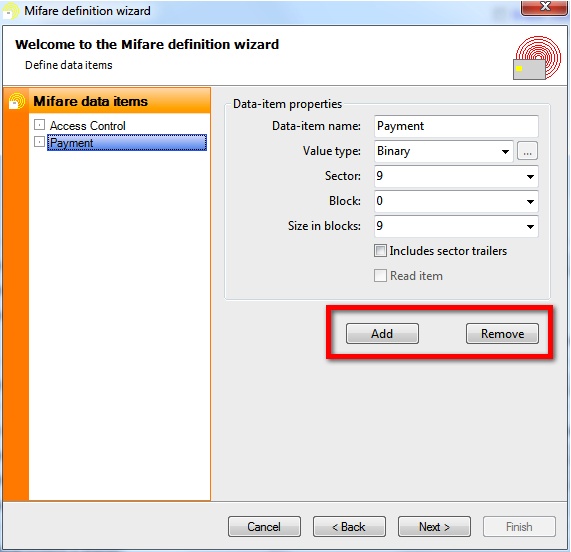

The navigator object on the left-hand side of this pages shows a list of all Data Items that have been defined. Data Items can be added and removed by using the respective buttons indicated with the red rectangle. By selecting a data item, its properties can be viewed and edited in the Data-Item Properties group on the right-hand side.
The Data Item name may include any character and can be freely chosen as long as the name is unique. The Data Item name is used in the card designer to uniquely identify the Data Item.
The Value Type determines which kind of data is read from or written to the data blocks. The options Text, Binary, Hexadecimal, and BCD treat the blocks as read/write blocks, whereas the option Value treats the blocks as value blocks. In the latter case, the size of the data item cannot be changed and is one by default. In the former case, data items can be an arbitrary number of blocks in size, as long as it does not exceed the size of the memory on the chip. The difference between the first three types is not in the way the data is stored, but in the way the data to be stored is provided. Text items expect strings and will store the ASCII codes of the individual characters. Binary items expect binary data to be copied into data blocks. Hexadecimal items expect strings that contain the hexadecimal representation of the binary data to be copied into the data blocks. BCD items expect integers and will store them as binary coded decimals.
The Sector and the Block number indicate where on the MIFARE® Classic card the first block of data of this item is located. Data Items are allowed to span various blocks, but always consist of a whole number of blocks. If a write item does not supply sufficient data for all indicated blocks, the data is supplemented with zeros.
By default, items that span various blocks will skip sector trailers when distributing the data over the subsequent blocks. If for example the item size is four blocks and the item is written to sector 3 block 1, the data will be distributed over sector 3 block 1 and 2 and sector 4 block 0 and 1, skipping the sector trailer of block 3. However, if the information to be written to the sector trailer is contained in the data item, the option Includes sector trailers should be checked to force the data item to include the sector trailers.
Click Next to proceed with the creation of the Classic Definition and go to Step 4.
